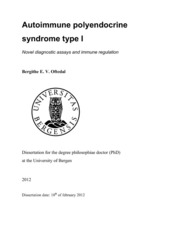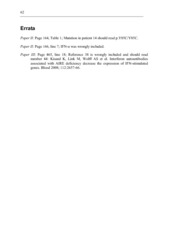| dc.contributor.author | Oftedal, Bergithe E. V. | en_US |
| dc.date.accessioned | 2012-05-09T08:48:17Z | |
| dc.date.available | 2012-05-09T08:48:17Z | |
| dc.date.issued | 2012-02-10 | eng |
| dc.identifier.isbn | 978-82-308-1955-5 | en_US |
| dc.identifier.uri | https://hdl.handle.net/1956/5792 | |
| dc.description.abstract | Autoimmune polyendocrine syndrome type I (APS-I) is a rare, monogenetic recessively inherited disease caused by mutations in the autoimmune regulator (AIRE) gene. The patients display different endocrine and ectodermal manifestations, where the majority develop at least two of the three main components of autoimmune adrenocortical failure (Addison’s disease), hypoparathyroidism and chronic mucocutaneous candidiasis (CMC). In addition, patients frequently develop autoantibodies against molecular targets in their affected organs and against cytokines of the immune system. In two studies, robust immunoassays detecting APS-I patients with high sensitivity and specificity were developed. Autoantibodies against in vitro transcribed and translated interferon omega (IFN- ) and interleukin (IL) 17F and IL-22 were measured, the latter shown to correlate to CMC. Antibodies against IFN- were confirmed as a universal marker for APS-I, suggesting this assay as an ideal screening tool preceding mutational analyses in suspected APS-I cases. We have shown that single nucleotide polymorphisms and variation in copy number of AIRE have no association with Addison’s disease. However, large deletions in one allele of AIRE together with a concomitant disease-causing mutation were discovered in two APS-I patients, underpinning the importance of copy number analysis. A wide range of immune cell subsets were studied, identifying disturbances in the regulatory T cell compartment together with less CCR6+CXCR3+ T cells and a reduction in CD16+ monocytes in patients with APS-I, possibly resulting in susceptibility for developing autoimmune manifestations. The characterisation of genetic variations in AIRE and of abnormalities in the immune cell subsets contribute to our understanding of the function of AIRE, while establishing immunoassays ease the identification of APS-I patients. | en_US |
| dc.language.iso | eng | eng |
| dc.publisher | The University of Bergen | eng |
| dc.relation.haspart | Paper I: A. S. Bøe Wolff, B. Oftedal, S. Johansson, O. Bruland, K. Løvås, A. Meager, C. Pedersen, E.S. Husebye, P.M. Knappskog. AIRE variations in Addison’s disease and autoimmune polyendocrine syndromes (APS): Partial gene deletion contribute to APS I. Genes and Immunity 9(2) :130-136, March 2008. Full text not available in BORA due to publisher restrictions. The article is available at: <a href="http://dx.doi.org/10.1038/sj.gene.6364457" target="blank"> http://dx.doi.org/10.1038/sj.gene.6364457</a> | en_US |
| dc.relation.haspart | Paper II: B. E. Oftedal, A. S. Bøe Wolff, E. Bratland, O. Kämpe, J. Perheentupa, A. G. Myhre, A. Meager, R. Purushothaman, S. Ten, E. S. Husebye. Radioimmunoassay for autoantibodies against interferon omega; its use in the diagnosis of autoimmune polyendocrine syndrome type I. Clinical Immunology 129(1): 163–169, October 2008. Full text not available in BORA due to publisher restrictions. The article is available at: <a href="http://dx.doi.org/10.1016/j.clim.2008.07.002" target="blank"> http://dx.doi.org/10.1016/j.clim.2008.07.002</a> | en_US |
| dc.relation.haspart | Paper III: A. S. Bøe Wolff, B. E. V. Oftedal, K. Kisand, E. Ersvær, K. Lima, E. S. Husebye. Flow Cytometry Study of Blood Cell Subtypes Reflects Autoimmune and Inflammatory Processes in Autoimmune Polyendocrine Syndrome Type I. Scandinavian Journal of Immunology 71(6): 459–467, June 2010. Full text not available in BORA due to publisher restrictions. The article is available at: <a href="http://dx.doi.org/10.1111/j.1365-3083.2010.02397.x" target="blank"> http://dx.doi.org/10.1111/j.1365-3083.2010.02397.x</a> | en_US |
| dc.relation.haspart | Paper IV: B. E. V. Oftedal, O. Kämpe, A. Meager, K. M. Ahlgren, A. Lobell, E. S. Husebye, A. S. Bøe Wolff. Measuring Autoantibodies against IL-17F and IL-22 in Autoimmune Polyendocrine Syndromes Type I by Radioligand Binding Assay Using Fusion Proteins Scandinavian Journal of Immunology 74(3): 327–333, September 2011. Full text not available in BORA due to publisher restrictions. The article is available at: <a href="http://dx.doi.org/10.1111/j.1365-3083.2011.02573.x" target="blank"> http://dx.doi.org/10.1111/j.1365-3083.2011.02573.x</a> | en_US |
| dc.title | Autoimmune polyendocrine syndrome type I. Novel diagnostic assays and immune regulation | en_US |
| dc.type | Doctoral thesis | |
| dc.rights.holder | Copyright the author. All rights reserved | |
| dc.subject.nsi | VDP::Medical disciplines: 700::Clinical medical disciplines: 750::General internal medicine: 770 | eng |
| dc.subject.nsi | VDP::Medical disciplines: 700::Basic medical, dental and veterinary science disciplines: 710::Medical genetics: 714 | eng |


